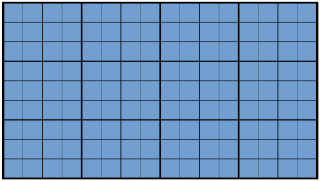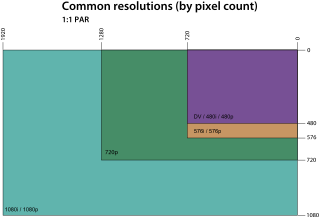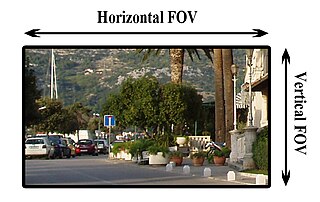
Letter-boxing is the practice of transferring film shot in a widescreen aspect ratio to standard-width video formats while preserving the film's original aspect ratio. The resulting video-graphic image has mattes of empty space above and below it; these mattes are part of each frame of the video signal.

Pan and scan is a method of adjusting widescreen film images so that they can be shown in fullscreen proportions of a standard-definition 4:3 aspect ratio television screen, often cropping off the sides of the original widescreen image to focus on the composition's most important aspects.

Standard-definition television is a television system that uses a resolution that is not considered to be either high or enhanced definition. Standard refers to offering a similar resolution to the analog broadcast systems used when it was introduced.

Widescreen images are displayed within a set of aspect ratios used in film, television and computer screens. In film, a widescreen film is any film image with a width-to-height aspect ratio greater than 4:3 (1.33:1).
Anamorphic widescreen is a process by which a comparatively wide widescreen image is horizontally compressed to fit into a storage medium with a narrower aspect ratio, reducing the horizontal resolution of the image while keeping its full original vertical resolution. Compatible play-back equipment can then expand the horizontal dimension to show the original widescreen image. This is typically used to allow one to store widescreen images on a medium that was originally intended for a narrower ratio, while using as much of the frame – and therefore recording as much detail – as possible.

16:9 is a widescreen aspect ratio with a width of 16 units and height of 9 units.

14:9 is a compromise aspect ratio between 4:3 and 16:9. It is used to create an acceptable picture on both 4:3 and 16:9 TV, conceived following audience tests conducted by the BBC. It has been used by most UK, Irish, French, Spanish, Colombian and Australian terrestrial analogue networks, and in the US on Warner Bros. Discovery' HD simulcast channels with programming and advertising originally compiled in 4:3. Note that 14:9 is not a shooting format; 14:9 material is almost always derived from either a 16:9 or 4:3 shot.

A video scaler is a system that converts video signals from one display resolution to another; typically, scalers are used to convert a signal from a lower resolution to a higher resolution, a process known as "upconversion" or "upscaling".
In television technology, Active Format Description (AFD) is a standard set of codes that can be sent in the MPEG video stream or in the baseband SDI video signal that carries information about their aspect ratio and other active picture characteristics. It has been used by television broadcasters to enable both 4:3 and 16:9 television sets to optimally present pictures transmitted in either format. It has also been used by broadcasters to dynamically control how down-conversion equipment formats widescreen 16:9 pictures for 4:3 displays.

A Pixel aspect ratio is a mathematical ratio that describes how the width of a pixel in a digital image compared to the height of that pixel.
1440p is a family of video display resolutions that have a vertical resolution of 1440 pixels. The p stands for progressive scan, i.e. non-interlaced. The 1440 pixel vertical resolution is double the vertical resolution of 720p, and one-third more than 1080p. QHD or WQHD is the designation for a commonly used display resolution of 2560 × 1440 pixels in a 16:9 aspect ratio. As a graphics display resolution between 1080p and 4K, Quad HD is regularly used in smartphone displays, and for computer and console gaming.

Windowboxing in the display of film or video occurs when the aspect ratio of the media is such that the letterbox effect and pillarbox effect occur simultaneously. Sometimes, by accident or design, a standard ratio image is presented in the central portion of a letterbox picture, resulting in a black border all around. It is generally disliked because it wastes much screen space and reduces the resolution of the original image. It can occur when a 16:9 film is set to 4:3 (letterbox), but then shown on a 16:9 TV or other output device. It can also occur in the opposite direction. Few films have been released with this aspect ratio — one example is The Crocodile Hunter: Collision Course, which had numerous scenes with Steve & Terri Irwin using widescreen pillar boxing.

Anamorphic format is the cinematography technique of shooting a widescreen picture on standard 35 mm film or other visual recording media with a non-widescreen native aspect ratio. It also refers to the projection format in which a distorted image is "stretched" by an anamorphic projection lens to recreate the original aspect ratio on the viewing screen. The word anamorphic and its derivatives stem from the Greek anamorphoo, compound of morphé with the prefix aná.

The technology of television has evolved since its early days using a mechanical system invented by Paul Gottlieb Nipkow in 1884. Every television system works on the scanning principle first implemented in the rotating disk scanner of Nipkow. This turns a two-dimensional image into a time series of signals that represent the brightness and color of each resolvable element of the picture. By repeating a two-dimensional image quickly enough, the impression of motion can be transmitted as well. For the receiving apparatus to reconstruct the image, synchronization information is included in the signal to allow proper placement of each line within the image and to identify when a complete image has been transmitted and a new image is to follow.

The display aspect ratio (DAR) is the aspect ratio of a display device and so the proportional relationship between the physical width and the height of the display. It is expressed as two numbers separated by a colon (x:y), where x corresponds to the width and y to the height. Common aspect ratios for displays, past and present, include 5:4, 4:3, 16:10, and 16:9.
"21:9" is a consumer electronics (CE) marketing term to describe the ultrawide aspect ratio of 64:27, designed to show films recorded in CinemaScope and equivalent modern anamorphic formats. The main benefit of this screen aspect ratio is a constant display height when displaying other content with a lesser aspect ratio.

A display resolution standard is a commonly used width and height dimension of an electronic visual display device, measured in pixels. This information is used for electronic devices such as a computer monitor. Certain combinations of width and height are standardized and typically given a name and an initialism which is descriptive of its dimensions.
The aspect ratio of an image is the ratio of its width to its height. It is expressed as two numbers separated by a colon, width:height. Common aspect ratios are 1.85:1 and 2.40:1 in cinematography, 4:3 and 16:9 in television, and 3:2 in still photography.

In first person video games, the field of view or field of vision is the extent of the observable game world that is seen on the display at any given moment. It is typically measured as an angle, although whether this angle is the horizontal, vertical, or diagonal component of the field of view varies from game to game.














